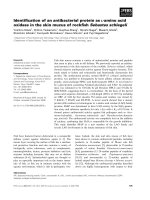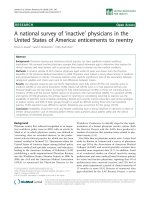Energy Storage in the Emerging Era of Smart Grids Part 11 pot
Bạn đang xem bản rút gọn của tài liệu. Xem và tải ngay bản đầy đủ của tài liệu tại đây (2.11 MB, 30 trang )
⎛⎞
⎜⎟
⎜⎟
⎝⎠
⎛⎞
⎜⎟
⎜⎟
⎝⎠
⎛⎞
⎛⎞
⎜⎟
⎜⎟
⎜⎟
⎜⎟
⎝⎠
⎝⎠
⎛⎞
⎛⎞
⎛⎞
⎜⎟
⎜⎟
⎜⎟
⎜⎟
⎜⎟
⎜⎟
⎝⎠
⎝⎠
⎝⎠
5. High temperature PEM fuel cell technologies
5.1 Fuel cell performance
−
≥
≥
Power / W
Vol t age( V) / Cur r ent ( A) / Temper at ur e( ℃ )
Temper at ur e
Power
Cur r ent
Vol t age
≥
≥
Vol t age( V) / Cur r ent ( A) / Temper at ur e( ℃
)
6. Conclusion
7. Acknowledgement
8. References
Practical Applications of Energy Storage
14
Energy Storage for Balancing
a Local Distribution Network Area
I. Grau Unda, P. Papadopoulos, S. Skarvelis-Kazakos,
L. M. Cipcigan and N. Jenkins
Cardiff University,
United Kingdom
1. Introduction
According to a study carried out for the formerly Department of Trade and Industry (DTI)
and the British regulatory authority (OFGEM), installed micro-generation capacity in the
UK could grow to as much as 8GW by 2015 (Energy Saving Trust, 2005; Ingram & Probert,
2003). This will require a new and highly decentralised approach to energy planning and
policy. In addition to resolving the everyday causes of power disturbances and outages at
local and regional levels, the electricity industry has to be able to restore service after major
events (e.g. floods and storms). Ensuring reliability has and will continue to be a priority.
The recent blackouts in UK (Blades, 2008; British Broadcasting Corporation [BBC], 2010)
highlight the significant public and private interest in electricity reliability. During times of
crisis caused by the rolling blackouts in California in 2001, it was found that customers are
willing to pay very high prices for reliable power (Lawton et al., 2003). Backup generation
ownership reveals that the owners place a high value on reliability, and therefore are willing
to pay for the cost of operating backup generation to reduce the impact of an actual outage.
Micro-generation can be used to sustain the distribution system during unavailability of the
transmission in-feeds and brings opportunities for the improvement of security of supply to
customers in major events, such as floods or storms (Kato et al., 2007; Kondo et al., 2008).
Energy storage systems have been identified as a potential source to support micro-
generation, to improve their carbon performance (Skarvelis-Kazakos et al., 2010) and to
offset the intermittency of renewable energy micro-sources (Grau et al., 2010).
Integration of individual small scale distributed generators in the low voltage (LV) side of the
grid could provide benefits for the customers, not only from an economic point of view but
also as an electric supply guarantee. Supply continuity could be reached by associating a
number of loads (customers) and micro-sources into different subsystems (micro-grids). Thus,
a micro-grid will be able to work in parallel with the grid, with the capability to switch to off-
grid mode (intentional islanded) in case of a grid emergency (Grau et al., 2009a).
Technical recommendations, such as G59/1 (Energy Network Association, 1991), G83/1
(Energy Network Association, 2008) and the standard 1547 from Institute of Electrical and
Electronics Engineers (IEEE, 2003), specify that micro-generation sources must be
disconnected in the case of loss of the grid. The fact that the micro-generation sources would
not be controlled by the utility grid in an islanded mode, could lead to operation beyond the
grid requirements. This could prove hazardous, not only for the utility equipment, but also
Energy Storage in the Emerging Era of Smart Grids
302
for the personnel’s health (Chowdhury et al., 2008). Embracing a reliable control strategy for
the islanded mode, could be defined as the key issue in the micro-grid development and
expansion. Such a strategy can maximise the micro-grid benefits, not only from the
customer’s point of view, but also from the utility system, since planned islanding operation
may be part of the utility planning and operation strategies.
This chapter is organised in the following way: Section 2 is concerned with the technical
challenges arising from intentional islanding of micro-grids that include micro-generation
sources. An overview of these challenges is provided together with the possible solutions
identified from the literature. A combination of an Energy Storage System (ESS) and a
backup generator is proposed as a solution for intentional islanding. A micro-grid model is
defined and used for steady state voltage studies using IPSA+ and PSCAD/EMTDC power
systems simulation software.
Section 3 analyses the ESS requirements to balance a local area, defined as a micro-grid in
this study. A methodology drawn from the literature (Abu-Sharkh et al., 2005) is used for
calculating the ESS requirements. Case studies using a micro-grid model are defined.
Section 4 evaluates the combined use of a backup generator and an ESS for balancing a local
area. A Java-based software tool performing sequential power flows was developed to
examine the ESS and the backup generator requirements under different micro-grid
load/generation conditions.
Section 5 uses the results from the previous sections to evaluate the use of ESS for electricity
market participation. The MATLAB Optimisation Toolbox is used to obtain the optimal
behavior of a pre-defined rated Energy Storage System, based on the requirements of a
given micro-grid.
The chapter concludes with the main results and summarises the conclusions of each
section.
2. Micro-grid intentional islanding
An overview of the main technical challenges regarding the grid-connected and islanded
mode of micro-grids is provided. Appropriate solutions drawn from the literature are
discussed. The use of energy storage and a backup generator is analysed. Part of a typical
LV power distribution network is used for steady state voltage studies. Case studies are
described and simulation results are analysed.
2.1 Technical challenges
When a micro-grid is to be operated at both grid-connected and islanded mode, frequency,
steady state voltage, protection and earthing issues arise. These issues are discussed for each
mode.
2.1.1 Frequency
2.1.1.1 Grid connected
Large centralised synchronous machines are equipped with speed governors, which are
responsible for ensuring the balance of the system they belong to and hence the network
frequency stability. Some micro-generation sources, are designed to operate with constant
power without contributing to frequency control, therefore large penetration of such
sources may lead to a less stiff system, determining the utility frequency stability (Lopes
et al., 2006).
Energy Storage for Balancing a Local Distribution Network Area
303
2.1.1.2 Intentional islanding
During islanded mode the micro-generation sources connected to the micro-grid may not be
able to provide frequency control. The low inertia of the synchronous micro-sources
together with the constant power output ones may be not sufficient for the micro-grid
frequency stability without the utility support. The smaller size of the resulted micro-grid
after islanding compared to the utility grids, give rise to a micro-system more sensitive to
power variations, where small unbalances may be translated in big and fast frequency
variations (Abu-Sharkh et al., 2006). The output of some micro-sources, such as PV and
wind turbines, depends on the intermittency of their renewable resources; therefore changes
in the power balance will not be only dependent on the load variation but also on the
available micro-source power output.
2.1.2 Steady state voltage
2.1.2.1 Grid connected
The operation of a micro-source within the LV side of the network is associated with a rise of
voltage at the point of connection (Conti et al., 2003). This can be seen as an opportunity for
micro-source penetration, since a higher margin against under voltages is achieved. On the
other hand, a high level of micro-source penetration could imply a violation of the upper
voltage statutory limits (+ 10% in UK [Ingram & Probert, 2003]) at the point of connection
(Jenkins et al., 2000). When networks are lightly loaded, voltage is more likely to violate
statutory limits. That is due to the tap settings of MV/LV transformers being traditionally set
to keep the voltage at the most remote customer just below the maximum limits (Jenkins et al.,
2000).
2.1.2.2 Intentional islanding
In general, micro-sources operate in slave mode (i.e. they set the grid voltage as reference for
their power electronics interfaces) when grid-connected. If due to the conditions prior to the
intentional islanding, the micro-sources have to be disconnected, a voltage source is
required to re-energise the micro-grid. Alternatively, the power electronics interface of one
micro-source has to operate in master mode. This may prove a complex task when more
micro-sources are added to the network, as the planning procedures of the Distribution
Network Operators (DNOs) should be enhanced. Moreover the micro-grid’s voltage will be
dependent on the micro-sources power output, which may prove inadequate in the case of
intermittent renewable micro-sources.
In high voltage electricity systems, reactive power compensation is used for the voltage
control. In the low voltage side of the network, though, active power flow control will be
critical to keep the voltage between statutory limits, due to the low X/R ratio. Therefore,
balance inside the micro-grid may not be achieved in islanded mode, since the maximum
active power flow along feeders will be limited (Zhou et al., 2007). The number of micro-
sources, the penetration level and their location along the micro-grid will determine the
voltage profile.
2.1.3 Protection
2.1.3.1 Grid connected
The electrical protection equipment of an electricity network is rated and operated
according to the fault levels and fault clearance times of faulty currents inserted from the
upstream network (Boutsika et al., 2005). When micro-sources are embedded in the
Energy Storage in the Emerging Era of Smart Grids
304
distribution network, an increase in the fault current levels is anticipated (Boutsika et al.,
2005). Therefore, the rating and characteristics of electrical protection equipment may no
longer be adequate to cope with the new fault current levels.
Traditional network protection schemes are based on unidirectional fault current flow.
Embedded micro-sources in LV networks may reverse power flows especially when
generation occurs at lightly loaded periods (Chowdhury et al., 2008).
2.1.3.2 Intentional islanding
An essential condition for the operation of micro-grids in an islanded mode is their
compliance to the same safety requirements as those traditional centralised-generation
operated networks (Jayawarna et al., 2005). In the case of a fault, the traditional grid
rotational generators are injecting large fault currents, thus protection devices in the
distribution network are mainly over-current sensing. The fault current emitted through the
power electronics interfaced micro-sources inside the micro-grid, will be below the levels of
traditional generators fault current (Jayawarna et al., 2005). Thus, possible faulty currents
from micro-sources may not be detected by existing over-current relays.
2.1.4 Unearthed neutral
Current practices allow micro-sources to operate with their neutral earthed or not, while
being synchronised to the utility system. The common practice is to earth only the neutral of
the low voltage side of the MV/LV transformer (Dexters et al., 2007). The main reason for
this is the degree of complexity in earth fault currents control, added by the neutral earth
connection of the micro-sources (Dexters et al., 2007). When the micro-grid is intentionally
islanded, an earth reference point should be provided. The lack of an earthed reference
could lead to over voltages and safety problems for the personnel in case of a fault.
2.2 Solutions for intentional islanding
2.2.1 Frequency and voltage, micro-source control strategy
It is anticipated that future micro-grids will comprise a Micro-Grid Central Controller
(MGCC) and dispersed micro-controllers for each micro-source and controllable load (Lopes
et al., 2006). The micro-source controllers will control the power electronic interfaces
(inverters) of the micro-sources. Two main strategies are currently used in inverter based
control schemes: PQ inverter control, where specified P and Q values are delivered by the
inverter, and Voltage Source Inverter (VSI), where voltage and frequency through P/f and
Q/V droops are controlled under predetermined limits. The VSI strategy could be
considered as more appropriate for islanded mode operation, since its behavior is similar to
that of synchronous machines. Nevertheless, both types of inverter control strategies can
coexist in an efficient way (Lopes et al., 2006). Load controllers will be mainly responsible
for load shedding when the power generated inside the system cannot match the demand.
Energy storage will play a key role in order to keep the frequency at the desired levels due
to its bi-directional power flow capability (Ito et al., 2007).
2.2.2 Protection
In (Wu et al., 2008) a method for adjusting the settings of relays is proposed. This method can
be used to modify the protection scheme during the transition from grid-connected to islanded
mode. Energy storage controllers could be programmed to introduce higher fault currents to
be detected by conventional protection devices. In (Jayawarna et al., 2005) a flywheel is
presented as a solution for the desirable fault currents while operating in islanded mode.
Energy Storage for Balancing a Local Distribution Network Area
305
2.2.3 Unearthed neutral
The earth reference of the micro-grids is usually located at the low voltage side of the
MV/LV transformer. The control of a micro-source neutral connection for switching on
during intentional islanding is proposed by (Dexters et al., 2007)
2.3 Energy storage and backup generator for intentional islanding operation
The connection of a backup generator and an energy storage device at the point of common
coupling is proposed to replace the grid after disconnection (Fig.1) and will be similar with
the spinning reserve of large generators in the conventional grid. The role of the energy
storage will be: (i) to absorb any excess of energy supplied by the micro-grid; (ii) to cope
with fast balance changes, and (iii) to ride-through the gap between the failure of grid
power and the start-up of the generator (Grau et al., 2009b). The generator will be
responsible for injecting power to the micro-grid for balancing purposes. Portable generator
for backup measures offers a feasible solution when permanent deployment is not possible.
The combination of energy storage, backup generator and micro-generators is anticipated to
manage the micro-grid demand requirements.
The loads may be domestic loads, commercial loads or electric vehicles.
Ideal intentional islanding control strategies should achieve a smooth transition without use of
load shedding. However, depending on the conditions prior to the intentional islanding, the
micro-sources may need to be disconnected. In such case, the micro-grid will need to integrate
black start capability in order to re-energise the system and re-start the micro-sources.
2.3.1 Micro-grid model for voltage studies
A LV micro-grid model, based on the UK generic network presented in (Ingram & Probert,
2003) is used. The model consists of a LV feeder modeled in detail, which supplies 96
residential customers, uniformly distributed among the 3-phases. Details of the whole
network can be found in (Ingram & Probert, 2003; Papadopoulos et al., 2010).
Fig. 1. Case study micro-grid
Legend
Micro-Generation
Circuit Breaker
Line Impedance
Load
Energy Storage
Backup Generator
Lum
p
ed Loads
M
V NETWORK
M
icro-Grid
μ
-G
μ
-G
μ
-G
μ
-G
Bup
ES
ES
Bup
μ
-G
Energy Storage in the Emerging Era of Smart Grids
306
2.3.2 Case study
During islanded operation the micro-grid’s demand is assumed to be covered by the power
generated from the micro-sources, the backup generator and the energy storage. Simplified
generation models were used to emulate the behavior of micro-generators. The domestic
loads were modeled as purely resistive with typical minimum and maximum values
acquired from the Electricity Association (Ingram & Probert, 2003). These are 0.16kW for a
summer minimum and 1.3kW for a winter maximum residential load. An After Diversity
Maximum Demand (ADMD) factor was applied per 100 customers.
Different levels of micro-generation penetration with a base scenario of 1.1kW per customer
were studied. 100% penetration is equivalent to each customer having installed a micro-
generator of 1.1 kW. The simulations were run for minimum and maximum loading
conditions and the steady state voltage measurements recorded. The voltage set at the point
of common coupling with the micro-grid was kept fixed at 1 p.u. IPSA+ and
PSCAD/EMTDC micro-grid system models were used to cross-check the simulation results.
2.3.3 Simulation results
The simulation results are presented in Fig. 2 and Fig. 3, in which the measurement of each LV
Segment is abbreviated with Seg, while Seg4 is the most remote segment in the micro-grid.
Fig. 2. Steady state voltage measurements at each LV segment during minimum load
conditions
Fig. 3. Steady state voltage measurements at each LV segment during maximum load
conditions
En
2.
3
T
h
–
0
fo
l
•
•
•
•
Fo
is
f
th
e
3.
T
h
an
el
e
de
en
(
A
so
u
th
e
3.
1
T
h
ca
l
g
e
n
Fi
g
A
v
G
e
P
o
bo
st
u
ergy Storage for B
a
3
.4 Discussion
o
h
e results present
0
.94p.u. in UK)
f
l
lowin
g
simulate
d
Small size of t
h
1 p.u. constant
Proximit
y
of t
h
Backup
g
ener
a
power.
r maximum load
f
lowin
g
from the
e
power is flowin
g
Balancing a l
o
h
e ener
gy
stora
ge
al
y
sed. A balan
c
e
ctricit
y
deman
d
mand. The met
h
er
gy
stora
g
e cha
r
A
bu-Sharkh et al.
,
u
rces and ener
gy
e
n extrapolated t
o
1
Calculation of
h
e micro-
g
enera
t
l
culated. The da
i
n
erators connect
e
g
. 4. Self-sufficie
n
v
era
g
e
g
eneratio
e
neration was as
s
o
wer (μ -CHP) u
n
th seasons (equ
a
u
died micro-sour
c
G
Generat
i
a
lancing a Local Di
s
o
f the results
ed in Fi
g
. 2 and
F
f
or different lev
e
d
conditions:
h
e micro-grid;
volta
g
e referenc
e
h
e reference volt
a
a
tor and ener
gy
scenario, it is fo
u
ener
gy
stora
g
e a
n
g
from the micro
-
o
cal area with
e
e
power and cap
a
c
ed area is a p
a
d
. To achieve se
l
h
odolo
gy
used t
o
r
acteristics in th
e
,
2005). In this a
p
y
stora
g
e within
a
o
the number of
h
sel
f
-sufficiency
t
ion capacit
y
r
e
i
l
y
demand of t
h
e
d to it.
n
t dwellin
g
n and demand
s
umed to come
f
n
its. The ener
gy
g
a
tions 1 and 2). B
c
es were derive
d
i
on=Demand
s
tribution Network
A
F
i
g
. 3 showed no
e
ls of penetratio
n
e
at the point of
c
ag
e to the remote
s
stora
g
e capabili
t
u
nd that until ap
p
n
d backup
g
ener
a
-
sources towards
t
e
nergy storag
e
a
cit
y
requiremen
t
a
rt of an electric
i
lf
-sufficienc
y
, t
h
o
obtain the micr
o
e
power balance
d
p
proach, the re
q
a
sin
g
le dwellin
g
h
ouseholds form
i
requirements
e
quired to sati
s
h
e dwellin
g
was
profiles for wi
n
f
rom PhotoVolta
i
g
enerated shoul
d
y
solvin
g
both i
n
d
.
D
Micro-C
o
A
rea
violation of the
s
n
. This could b
e
c
ommon couplin
g
s
t part of the se
gm
ty
to absorb an
d
p
roximatel
y
100%
a
tor to the loads.
A
t
he ener
gy
stora
g
e
t
s to achieve a p
o
i
t
y
network, sel
f
e
g
eneration sh
o
o
-
g
eneration pe
n
d
area is based o
n
q
uired combinati
o
g
are calculated.
T
i
n
g
the micro-
g
ri
d
s
f
y
the dwellin
g
assumed to be
s
n
ter and summ
e
i
cs (PV) and mic
r
d
satisf
y
the dem
a
n
equalities, the p
Phot
o
Ener
gy
o
mbined Heat a
n
s
tatutor
y
limits (
1
e
a consequence
g
;
m
ent;
d
to in
j
ect the re
q
penetration, the
A
fter 100% pene
t
g
e (Fi
g
. 3).
o
wer balanced a
r
f
-sufficient in te
r
o
uld alwa
y
s m
e
n
etration levels a
n
n
the work prese
n
on
of micro-
g
en
e
T
hese requireme
n
d.
g
dail
y
deman
d
s
upplied b
y
the
e
r seasons were
r
o-Combined H
e
a
nd of the dwell
i
enetration levels
o
voltaic Unit
Stora
g
e Unit
n
d Power Unit
307
1
.1p.u.
of the
q
uired
power
t
ration,
r
ea are
r
ms of
e
et the
n
d the
n
ted in
e
ration
n
ts are
d
was
micro-
used.
e
at and
i
n
g
for
of the
Energy Storage in the Emerging Era of Smart Grids
308
nE
CHPwin
+ mE
PVwin
≥ E
dwin
(1)
nE
CHPsum
+ mE
PVsum
≥ E
dsum
(2)
Where
E
CHP
is the electric energy generated by the μ-CHP,
E
PV
is the energy generated by the PV,
E
d
is the energy demand,
n is the penetration levels for μ-CHP and
m the penetration levels for PV.
The sub indexs win and sum stand for winter and summer respectively.
Once the generation values were input, the characteristics of the required energy storage
(maximum power and capacity requirements) were acquired. The value for a single
household was then extrapolated to the number of customers forming the micro-grid.
3.2 Case study input data
Half-hourly residential load profiles where drawn from (UK Energy Research Center, 1997),
and scaled to values for the specific model (from 0.16kVA to 1.3kVA per customer) provided
in section 2. These profiles are deemed to be representative for the UK residential loads.
Generation profiles for the PV and μ-CHP were used from (Mott McDonald, 2004) for
winter and summer average days. The μ -CHP profiles were scaled to a maximum electrical
power output of 1.5kWe. The data are shown in Fig. 5 and Fig. 6.
Fig. 5. Winter generation and demand profiles
Fig. 6. Summer generation and demand profiles
Energy Storage for Balancing a Local Distribution Network Area
309
3.3 Case study results
The methodology described in section 3.1 was applied and the results were extrapolated to a
micro-grid consisting of 96 customers and one energy storage unit. Fig. 7 shows the
graphical solutions of equation 1 and equation 2, using the data from section 3.2, which
gives the micro-generation penetration levels required in each season to achieve the micro-
grid balance. The intersection point indicates the optimal penetration levels required in
order to achieve the balance in both seasons (Abu-Sharkh et al., 2005).
Fig. 7. Micro-generation penetration required to achieve the balance in the micro-grid
The intersection co-ordinates are m=0.34 and n=0.84, where m is the required PV
penetration and n is the required μ-CHP penetration level. These penetration levels were
applied to the generation profiles. By comparing the generation against the demand the
energy imported from the grid and to the grid at each time interval was obtained.
The maximum energy storage capacity for each season was determined by plotting the
evolution of the energy storage State of Charge (SoC), as described below. The power was
assumed to be constant at each half-hourly interval; therefore the periods where the maximum
energy was absorbed or injected to the grid determined the maximum power requirements.
Fig. 8. Evolution of the energy storage during summer load conditions
Fig. 8 and Fig. 9 show the utilisation of the energy storage during typical summer and
winter days for the optimal micro-generation penetration levels (Fig. 7). The black columns
-40
-20
0
20
40
-250
-200
-150
-100
-50
0
50
100
150
200
250
1 5 9 131721252933374145
State of Charge (kWh)
E Injected/Absorbed SoC
Time (Half Hourly Interval)
Energy (kWh)
Energy Storage in the Emerging Era of Smart Grids
310
correspond to the energy injected or absorbed by the energy storage unit at each time step.
The negative values represent the energy injected by the energy storage unit; conversely the
positive values represent the energy absorbed by the energy storage unit. The energy
injected/absorbed is presented on the figures’ right axis (black). The grey line represents the
evolution of the energy storage State of Charge (SoC) during the day. The SoC values are
presented on the figures’ left axis (grey). The maximum value of the grey line determines
the capacity required by the energy storage in each season. The sizing of the energy storage
in order to achieve self-sufficiency was found to be 236.27 kWh, which is the maximum
value of the two seasons.
Fig. 9. Evolution of the energy storage during winter load conditions
The power and energy requirements of the energy storage system are summarised in Table 1.
Season
Maximum
Power injected
(kW)
Maximum
Power absorbed
(kW)
Capacity
required
(kWh)
Total Energy
injected
(kWh)
Total Energy
absorbed
(kWh)
Summer
-36.80 68.88 236.27 -251.68 251.68
Winter
-29.47 65.96 151.17 -202.55 202.55
Table 1. Energy storage requirements for summer and winter scenarios for the micro-grid
4. Balancing a local area with energy storage and backup generator
This section investigates the power rating and energy capacity requirements for the energy
storage and backup generator to achieve a balanced area. Different penetration levels of PV
and μ-CHP were used. The micro-grid model shown in Fig.1 was considered.
The steady state voltage changes and the system efficiency (power line losses) are evaluated
for different penetration levels of micro-generation. A study case is presented, where the use
of backup generator is minimised.
4.1 Methodology
The penetration levels considered for each micro-source range from 0% to 100% in steps of
10%. For each combination of micro-sources penetration level, sequential power flows were
-40
-20
0
20
40
-200
-150
-100
-50
0
50
100
150
200
1 5 9 13 17 21 25 29 33 37 41 45
State of Charge (kWh)
E Injected/Absorbed SoC
Time (Half Hourly Interval)
Energy (kWh)
Energy Storage for Balancing a Local Distribution Network Area
311
performed at every time interval. The procedure was repeated for both summer and winter
system conditions. The power line losses and the voltage steady state measurements were
recorded for each time interval. The policy examined was to minimise the use of the backup
generator. Once the losses were recorded, the need of a backup generator was estimated.
The parameters considered were: (i) the system energy generation and demand, the (ii)
energy storage efficiencies and (iii) the line losses. A round-trip efficiency of 72% was
assumed for the ESS (Oudalov et al., 2007).
A backup generator was required in the case that:
48 48
tt
11
E
g
en - Edem 0
tt==
<
∑∑
(3)
Where:
Where for each time step t:
Egen is the usable energy stored in the energy storage system,
Edem is the micro-grid required energy,
Gen is the energy generated by the micro-sources,
Dem is the domestic demand,
ηch is the energy storage charging efficiency and
ηdch is the energy storage discharging efficiency.
The flow chart in Fig. 10 depicts the developed algorithm. This chart shows the case where
the overall system demand is higher than the generation. The calculations consider two
consecutive days (i.e. 96 half hour time steps). The procedure is done for each combination
of micro-sources for summer and winter season.
In time steps where the generation is higher than the demand, the energy stored in the ESS, is:
Ein=[( Gen
t
– Dem
t
) - losses
t
]* ηch (4)
If the demand is higher than the generation, the algorithm checks if there is energy available
in the energy storage system (SoC
t
>0). In this case the energy supplied by the ESS is:
Eout = [(Dem
t
- Gen
t
) + Losses
t
] / ηdch (5)
If additional energy is required than the available energy in the ESS (SoC
t+1
<0), the ESS will
supply its available energy and the rest is supplied by the backup generator.
If the demand is higher than the generation and there is no energy available in the ESS, the
energy is supplied by the backup generator:
EBup = (Dem
t
- Gen
t
) + Losses
t
(6)
Egen
t
=
Edem
t
=
[(Gen
t
-Dem
t
) - Losses
t
] * ηch * ηdch, Gen
t
- Dem
t
>0
0, Gen
t
- Dem
t
<0
0, Gen
t
- Dem
t
>0
[
(
Dem
t
-Ge
n
t
)
+ Losses
t
], Ge
n
t
-Dem
t
<0









